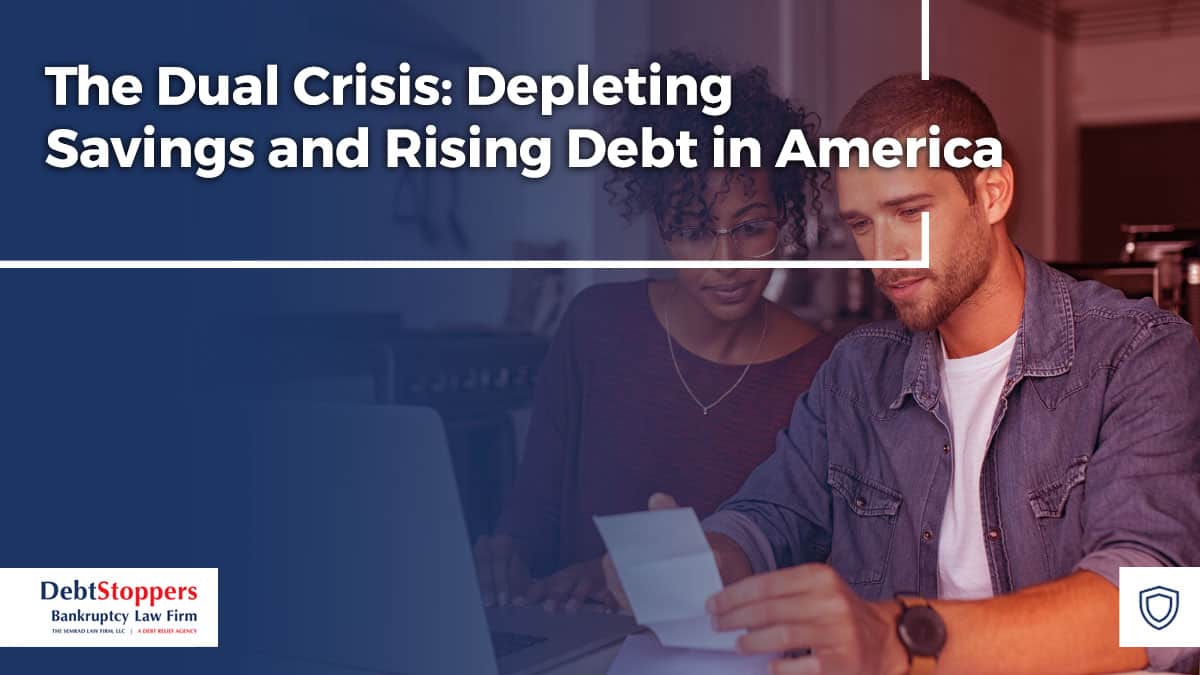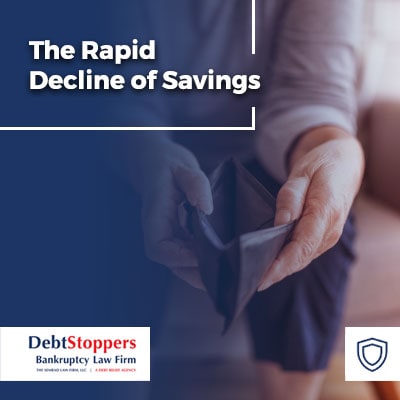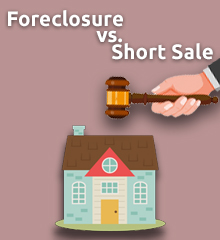The Dual Crisis: Depleting Savings and Rising Debt in America

In a recent report from the Federal Reserve Bank of San Francisco, a concerning trend has been highlighted: American households are depleting their pandemic-era savings at an alarming rate, leaving them vulnerable to spending and debt. This trend sheds light on a critical issue that affects many Americans today.
The Rapid Decline of Savings
According to the Federal Reserve Bank of San Francisco, many U.S. households are facing a dire financial situation. Their savings are dwindling rapidly in a high-inflation economy, a trend that could leave them vulnerable to mounting debt. As the report "Excess No More? Dwindling Pandemic Savings" indicates, aggregate excess savings may fall to a zero by fall 2023.
When Savings and Debt Coexist
Curiously, several individuals maintain savings while concurrently accumulating significant debt. In these situations, they frequently use their savings to meet minimum payments on high-interest credit cards and personal loans—a short-term solution that depletes long-term wealth. It’s a paradox that baffles many: how can someone have savings while simultaneously accumulating significant debt? For many individuals, this is a reality shaped by a combination of fear, uncertainty, and strategic decision-making, albeit often short-term in nature.

The Emotional Security of Savings
For many, savings represent more than just money; they symbolize security and peace of mind. Even when facing substantial debt, individuals are hesitant to tap into these savings, preferring to view them as a safety net for future uncertainties, such as medical emergencies or job loss. This emotional attachment to savings can lead to a situation where people are paying high interest on debts while holding onto savings that yield much lower interest.
The Debt Cycle
In some instances, individuals turn to their savings only to meet minimum payments on high-interest credit cards and personal loans without reducing the principal. While this strategy prevents immediate default on debts, it gradually depletes savings. As the savings dwindle, people may then resort to accruing more debt to cover essential expenses, thereby perpetuating a vicious cycle of debt accumulation and savings depletion.
The High Cost of this Strategy
Using savings to meet minimum payments is essentially reallocating your future wealth to service present debt. When savings are used to pay off high-interest loans, individuals are slowly, but surely, eroding their net worth. Over time, the high interest rates on the remaining debt can surpass the original amount borrowed, turning what was intended as a short-term solution into a long-term financial burden.
The Insufficiency of Traditional Advice
Conventional financial advice, which often centers on curtailing spending to pay down high-interest credit card or personal loans, falls short for many. For those overwhelmed by debt, there is often no amount of budgetary cutting that can extract them from their financial hole. Traditional advice assumes expendable income, which is not the case for everyone.
A Call for Rethinking Strategy
Instead of allowing savings and debt to coexist in this precarious balance, individuals should consider a comprehensive financial strategy. This might include aggressive debt repayment plans, negotiating with creditors for lower interest rates or settlements, and talking to a bankruptcy attorney before the savings are entirely depleted.
The Misconception of Bankruptcy
There is a widespread misunderstanding that filing for bankruptcy equates to having nothing. On the contrary, bankruptcy is a legal tool designed for those overwhelmed by debt, and it is structured to protect one's assets—including a reasonable amount of cash. The word 'bankruptcy' often conjures images of destitution and financial ruin, but this perception is far from the complete truth. There is a widespread misunderstanding that filing for bankruptcy equates to having nothing. In reality, bankruptcy is a legal tool designed for those overwhelmed by debt, and it has specific provisions in place to protect one’s assets. Here, we debunk some common misconceptions about bankruptcy:

Bankruptcy as a Fresh Start, Not a Failure
Bankruptcy is not an admission of failure, but a strategic step towards financial health. It provides a fresh start by allowing individuals to restructure, reduce, or eliminate their debts while protecting their assets under the law. For many, it’s the first step towards reclaiming financial stability.
Protection of Assets is a Priority
One of the key principles of bankruptcy law is the protection of a debtor's assets. This includes a reasonable amount of cash, equity in a home, personal belongings, and retirement accounts. Laws called 'exemptions' outline what property is off-limits to creditors, ensuring individuals are not left destitute.
You Don’t Need to Be Broke to File for Bankruptcy
A prevalent misconception is that one must be completely broke to file for bankruptcy. This is not the case. Many people who file for bankruptcy have regular income but are overwhelmed by the size of their debt relative to that income. Bankruptcy can be a proactive decision made to prevent the depletion of savings and assets.
Bankruptcy Can Improve Future Creditworthiness
Contrary to popular belief, filing for bankruptcy can eventually lead to improved credit. While a bankruptcy filing will impact your credit score initially, it eliminates many of the debts that might have caused the score to plummet in the first place. With proper financial management post-bankruptcy, individuals often find they can rebuild their credit faster than if they continued to struggle with insurmountable debt.
Why Timing Matters
Most clients come to see me when they have already depleted their savings. My encouragement to those experiencing rising spending while their savings are depleting is to act before desperation sets in. If you are already in over your head with debt, don’t wait until the last second to seek advice from a bankruptcy attorney. Come see us while you still have options.
Conclusion
As the recent report from the Federal Reserve Bank of San Francisco has highlighted, many Americans are in a precarious position—caught between depleting savings and mounting expenses. In this landscape, we must challenge the traditional advice that has proven ineffective for so many and start addressing the real issues: our expenses and our approach to debt.
By acting proactively, we can make informed decisions based not on desperation but on sound planning for the future. Bankruptcy doesn't mean you're left with nothing; it is a legal tool designed to give you a fresh start while protecting your essential assets.





